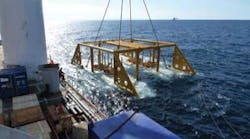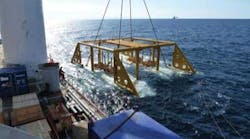New hydrate skid offers deepwater remediation option
System includes a number of environmentally friendly features, and its pump is powered by filtered sea water
Eldon Ball
Senior Editor, Technology & Economics
Editor’s note: To view a video of the hydrate skid in operation, visit www.offshore-mag.com/hydrateskid.
Editors Note: this article was based on information supplied by Fernando Hernandez, WWCS deepwater operations manager.
A new hydrate remediation system from Wright’s Well Control Services (WWCS) recently cleared a hydrate-blocked pipeline in the Gulf of Mexico (GoM) in 7,200 ft (about 2,100 m) of water. According to Wright’s President David C. Wright, the WWCS skid provides previously unavailable functionality, as it does not depend on hydraulic energy from an ROV. Instead, he says, it is a completely independent system powered via surface from a multi service vessel.
The hydrate removal system recently cleared a hydrate-blocked pipeline in the Gulf of Mexico in 7,200 ft of water.
This capability, says Wright, allows the subsea pump volume to increase up to 42 gpm rather than the 2 to 10 gpm typical of ROV-mounted pumps, or the WWCS system can reverse flow, drawing pressure down to a sub-ambient -12 psi. For the recent project, the integrated skid cleared 15 mi (24 km) of 12-in. pipeline, removing 9,000 bbl of condensate, hydrocarbons, gases, and other fluids.
System design
The skid is comprised of a motor and pump assembly powered from the surface through coiled tubing. The skid has a redundant motor and pump assembly, Wright says, that allows operations to continue should there be any trouble with the setup being used.
The gas separator can be partitioned into two segments. The first segment is responsible for charging the accumulators for emergency quick disconnections and locking the EQD, which is responsible for gas returns and preventing hydrate blockages in the coiled tubing outtakes. The second segment is solely responsible for the different points of ejection in the system.
According to Wright, the system is further protected from hydrate blockages between the pipeline end termination/flowline end termination and the skid by injecting dispersant and chemicals from an ROV panel as needed.
The system includes multiple gauges on the skid and separator to measure and interpret the behavior of the internals of the pipeline. The monitoring devices are all designed to monitor a combination of pressures, Wright says. This capability is needed, he says, due to the skid’s ability to pull a vacuum within a pipeline. When this is accomplished, the pipeline or the internal hydrate sources will have a pressure differential due to the hydrostatic pressure, and when this happens the internals of a pipeline will ultimately be below sub-ambient, which will then require the operator to monitor in absolute pressure.
By using both analog and digital gauges, the operator is equipped to keep a diligent view of all segments of the equipment, says Wright. “Likewise, what a transducer provides is the utilization of data logging equipment. Such data is relayed back to the ROV control room from where the data is not only logged/monitored but also gives a real-time and historical log that is charted.”
The charting of data ultimately indicates what kind of process is being made in regards to the hydrate, Wright says.
In addition to ultra deepwater capabilities, the hydrate remediation system can be reconfigured for shallow and inland-water pipelines, he says. Depending on water depth, the skid can clear pipelines with diver assistance or directly by operation from the surface.
Deployment
Prior to the skid being over-boarded via a crane on a multi-service vessel (MSV), mud mats are placed on the ocean floor to keep the skid above the mud line. In essence, Fernando Hernandez, WWCS deepwater operations manager says, they provide extra stability and support. With the mud mats in place, the skid is then deployed from the MSV, and upon reaching the splash zone, the skid is lowered to its operational depth and set on the mats.
The gas separator is also over-boarded and mated to the skid via a 4-in. connector. When both items (skid and separator) are synchronized, the skid is fully armed and only requires appropriate connections, Wright says.
From surface the skid is connected at four different points. At each point a 2-in. hot stab is engaged. Two of these points are designated to run the pump and motors on the hydrate skid. The third stab mates at the skid and is designated for fluid/condensate returns, while the fourth and final stab is connected at the gas separator, where it returns gas to the surface.
At the surface, the choke methodically designates the separated condensate and gas to the appropriate circuitry, Wright says. From there, the gas and condensate are displaced and contained in an environmentally safe tank. The gas then flows through a surface gas separator and is then vented to the atmosphere or flared.
At this level the gas and condensate returns are measured and the amount of each particular medium is analyzed, as it is a direct manifestation of what is internally trapped inside of the affected source. The choke also acts as a safety barrier that allows the personnel on the back deck to shut in and keep gas and condensate returns contained.
Equally, he says, the choke can isolate both items at liberty, if the gas pressure needs to be analyzed then the choke is closed and the pressure is monitored at surface, while allowing condensate returns to flow freely. The choke can also be adjusted to restrict the amount of gas which will be returning on surface, while allowing the condensate to remain unrestricted. By doing this, the operator can further affect the hydrate remediation process.
Safety and environment
When an MSV is being used, however, there is a possibility of it losing dynamic positioning or complete power, he says. “If this occurs, the MSV will be at the mercy of the winds and currents of the sea.”
The skid and separator that are part of the system can safely respond through an emergency quick disconnect via a contingency hydraulic circuit. The hydraulic circuit is powered via accumulators that are pre-charged on the surface to activate remotely, he says, and the accumulator pressure is adjusted to compensate for the operational depth. The accumulators provide an isolated source of hydraulic power that ejects all four EQDs that are mated to the hydrate system.
The system includes a triple-redundant safety system to compensate for a loss of dynamic positioning (DP) or drive-off by the MSV from which the hydrate skid is deployed, Wright says. “An emergency quick disconnect removes the skid’s coiled tubing connections via four hot stabs. Accumulators provide an isolated source of hydraulic power for the EQD that can be activated acoustically from the MSV, with ROV manipulators, or as a last resort with wire ropes. The safety system eliminates potential damage to the pipeline asset from the hydrate skid dragging across the seabed or thousands of feet of coiled tubing crashing down on the remediation site.”
The skid includes a number of environmentally friendly features, he says. The pump is powered by filtered sea water, avoiding any adverse impact from leaking or severing of the coiled tubing. The fluids the hydrate pump sends to the surface are contained in a specially designed tank on the deck of the MSV. Lastly, in the event of a MSV drive-off or loss of DP, emergency shut-off valves minimize the release of any hydrocarbons from the coiled tubing outtakes after an EQD. WWCS is currently developing a flush loop to eliminate any hydrocarbon released from an EQD deployment, says Wright.
Offshore Articles Archives
View Oil and Gas Articles on PennEnergy.com

